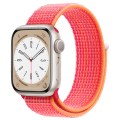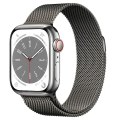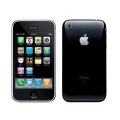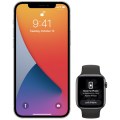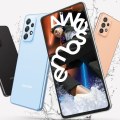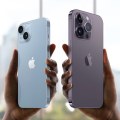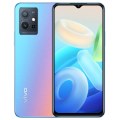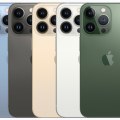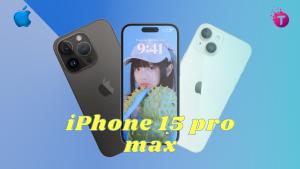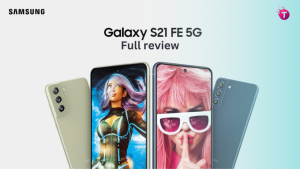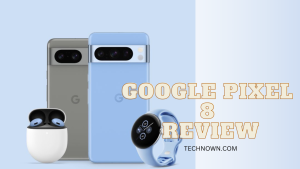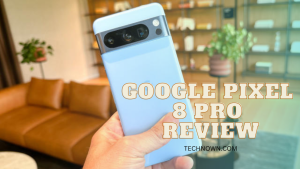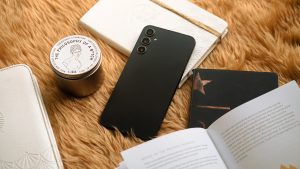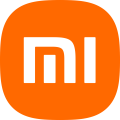Apple iPhone 15 Pro Max
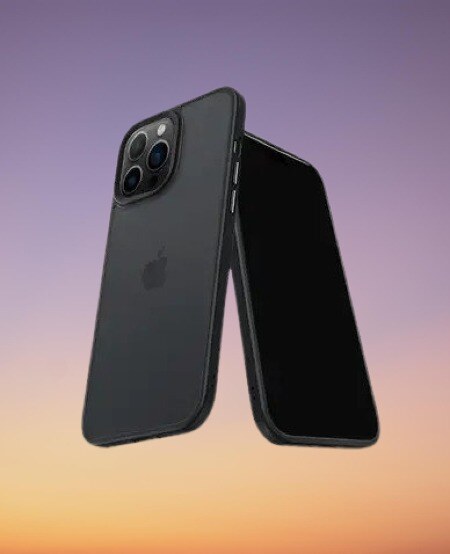


-
CPU: Hexa-core (2x + 4x)
-
RAM: 8GB
-
Storage: 256GB/512GB/1TB
-
Display: 6.7 inches, 110.2 cm2
-
Camera: 48 MP, f/1.8, 24mm (wide), 1/1.28", 1.22µm, dual pixel PDAF, sensor-shift OIS
-
OS: iOS 17
Introduction
In the ever-evolving world of smartphones, Apple continues to set the bar higher with each new release. The iPhone 15 Pro Max, the latest addition to Apple’s iconic lineup. Has generated significant buzz and anticipation among tech enthusiasts and Apple fans alike. With cutting-edge technology, innovative features and a sleek design. The iPhone 15 Pro Max promises to be a game-changer in the smartphone market. In this blog, we’ll take a closer look at what sets the Phone’s apart from its predecessors and competitors.
Design and display
The first thing that strikes you about the iPhone 15 Pro Max is its stunning design. Apple has always been synonymous with sleek. And premium aesthetics and this model is no exception. iPhone 15 Pro Max has a glass front and a stainless steel frame on the back. Conveying a sense of luxury and sophistication.
One of the most notable features is its display. The 6.7-inch Super Retina XDR OLED display delivers vivid colors. Deep blacks and outstanding brightness. It supports a resolution of 2778 x 1284 pixels, resulting in sharp and detailed visuals. With Promotion technology, the screen’s refresh rate dynamically adjusts from 10Hz to 120Hz. Providing smoother scrolling and more responsive touch interaction.
performance
Under the hood, the iPhone 15 Pro Max is powered by Apple’s A16 Bionic chip, a marvel of engineering. This chip boasts advanced CPU and GPU performance. Making it incredibly fast and efficient. Whether you’re multitasking. Gaming or running demanding apps, the iPhone 15 Pro Max handles it all with ease.
The device offers up to 1TB of storage, ensuring you never run out of space for your photos, videos and apps. With 5G connectivity, you can enjoy faster download speeds and lower latency. Making streaming, online gaming and video calls a seamless experience.
Camera system
Apple has always been at the forefront of smartphone photography. And the iPhone 15 Pro Max takes it one step further. The rear triple-camera system includes a 12MP primary sensor. A 12MP ultra-wide-angle lens and a 12MP periscope telephoto lens. This combination delivers exceptional photo and video quality, even in challenging lighting conditions.
Night mode has been improved, allowing for stunning low-light photography. The periscope telephoto lens offers up to 10x optical zoom. Enabling you to capture distant subjects with extraordinary clarity. ProRAW and ProRes video recording capabilities provide advanced options for professional photographers and videographers.
Software and Features
It runs on iOS 16, Apple’s latest operating system. Focusing on user privacy and security, iOS 16 introduces new features like App Privacy Reports. Which lets users see how apps are using their data, and Mail Privacy Protection. Which prevents senders from knowing when emails are opened.
Face ID, Apple’s facial recognition technology. Has been improved for faster and more accurate authentication. The device also supports MagSafe, so MagSafe accessories like cases. Chargers and wallets can be easily attached.
Battery life
With the Phone, you can expect impressive battery life. The larger battery combined with the efficient A16 Bionic chip ensures. That your device lasts all day, even after heavy usage. Additionally, fast charging and wireless charging options are available. So you can quickly top up your battery when needed
Conclusion
The Apple iPhone 15 Pro Max represents a significant advancement in smartphone technology. From its stunning design and high-quality display to its powerful performance. And advanced camera system, this is a device. That meets the needs of both casual users and professionals. With iOS 16 and a focus on user privacy, Apple continues to focus on both functionality and security. If you’re in the market for a premium smartphone that pushes the boundaries of what’s possible. The iPhone 15 Pro Max is a clear choice and a glimpse into the future of mobile technology.
Specs
General
| Device Type | Smartphone |
| Model | A2849, A3105, A3106, A3108 |
| Announced | 12 September, 2023 |
| Released | 23 November, 2024 |
| Status | Coming Soon |
| Price | 215000 |
Design
| Type <strong>Design Type</strong> called form factor refers to a mobile phone's size, shape, and style as well as the layout and position of major components of phone. There are three major form factors seen in mobile phones => bar phones, folding phones and sliding phones. | Bar |
| Dimensions | 159.9 x 76.7 x 8.3 mm (6.30 x 3.02 x 0.33 in) |
| Weight | 221 g (7.80 oz) |
| Protection |
Glass Front (Corning Ceramic made Glass), Glass Back (Corning Ceramic-made Glass), Titanium Frame (Grade 5) |
| Colors |
Black Titanium, White Titanium, Blue Titanium & Natural Titanium |
Network
| 2G Network |
GSM 850 / 900 / 1800 / 1900 - SIM 1 & SIM 2 (dual-SIM) CDMA 800 / 1900 |
| 3G Network |
HSDPA 850 / 900 / 1700(AWS) / 1900 / 2100 CDMA2000 1xEV-DO |
| 4G Network |
1, 2, 3, 4, 5, 7, 8, 12, 13, 17, 18, 19, 20, 25, 26, 28, 30, 32, 34, 38, 39, 40, 41, 42, 46, 48, 53, 66 - A3106 1, 2, 3, 4, 5, 7, 8, 12, 13, 14, 17, 18, 19, 20, 25, 26, 28, 29, 30, 32, 34, 38, 39, 40, 41, 42, 46, 48, 53, 66, 71 - A2849 1, 2, 3, 4, 5, 7, 8, 11, 12, 13, 14, 17, 18, 19, 20, 21, 25, 26, 28, 29, 30, 32, 34, 38, 39, 40, 41, 42, 46, 48, 53, 66, 71 - A3105 1, 2, 3, 4, 5, 7, 8, 12, 13, 17, 18, 19, 20, 25, 26, 28, 30, 32, 34, 38, 39, 40, 41, 42, 46, 48, 66 - A3108 |
| 5G Network |
1, 2, 3, 5, 7, 8, 12, 20, 25, 26, 28, 30, 38, 40, 41, 48, 53, 66, 70, 77, 78, 79 SA/NSA/Sub6 - A3106 1, 2, 3, 5, 7, 8, 12, 14, 20, 25, 26, 28, 29, 30, 38, 40, 41, 48, 53, 66, 70, 71, 77, 78, 79, 258, 260, 261 SA/NSA/Sub6/mmWave - A2849 1, 2, 3, 5, 7, 8, 12, 14, 20, 25, 26, 28, 29, 30, 38, 40, 41, 48, 53, 66, 70, 71, 75, 76, 77, 78, 79 SA/NSA/Sub6 - A3105 1, 2, 3, 5, 7, 8, 12, 20, 25, 26, 28, 30, 38, 40, 41, 48, 66, 70, 77, 78, 79 SA/NSA/Sub6 - A3108 |
| SIM <strong>SIM</strong> (Subscriber Identity Module) is a small card that contains mobile network subscriber's account information. This allows the phone using the card to attach to a mobile network. The SIM card is most commonly associated with GSM and UMTS mobile networks. Moving a SIM card from one phone to another allows a subscriber to switch mobile phones without having to contact their mobile network carrier. SIM cards can also be used by a phone to store limited amounts of data, such as phone numbers and text messages. | Nano SIM |
| Dual SIM | Yes |
Display
| Display Type <strong>Display Technology => </strong> A number of display technologies and types used in mobile phones => TFT (Thin Film Transistor), IPS (In-Place Switching), OLED (Organic Light Emitting Diode), AMOLED (Active-Matrix Organic Light-Emitting Diode), Super AMOLED (an even advanced version of AMOLED), Resistive Touchscreen (Resistive touchscreens contain two layer of conductive material with a very small gap between them which acts as a resistance), Capacitive Touchsceen (Capacitive touchscreen technology consists of a layer of glass coated with a transparent conductor) | LTPO Super Retina XDR OLED capacitive touchscreen, 16M colors |
| Size | 6.7 inches, 110.2 cm2 |
| Resolution | 1290 x 2796 pixels |
| Pixel Density <strong>Pixel Density (PPI)</strong> is refers to the concentration of pixels on a particular display, measured in pixels per inch (ppi). Pixel density is calculated by dividing the diagonal pixel resolution of a display by its diagonal size, higher pixel density better display quality. | 460 ppi density |
| Touch Screen | Yes |
| Display Protection <strong>Display Protection => </strong> Gorilla Glass is a special alkali-aluminosilicate glass shield with exceptional damage resistance that helps protect mobile displays from scratches, drops, and bumps of everyday use, It is always better to go for a smartphone with Gorilla Glass for that added protection and peace of mind. | Ceramic Shield Glass |
| Features |
- HDR10 - Dolby Vision - Always-On display - 120Hz Refresh rate (ProMotion technology) - 1000 nits (typ) brightness - 1600 nits (HDR) peak brightness - 2000 nits (HBM) brightness - Wide color gamut (P3) - Haptic Touch - True Tone |
Media
| Alert Types | Vibration, MP3, WAV ringtones |
| Loudspeaker | Yes |
Camera
| Primary <strong>Camera</strong> is able to capture photographs and usually videos, The most important characteristics of a camera are the resolution (measured in megapixels), lens focus type (fixed or automatic), higher megapixel cameras are known to capture higher quality photos, but not always a good measurement of the photos quality. | 48 MP, f/1.8, 24mm (wide), 1/1.28", 1.22µm, dual pixel PDAF, sensor-shift OIS 12 MP, f/2.8, 120mm (periscope telephoto), 1.12µm, dual pixel PDAF, 3D sensor‑shift OIS, 5x optical zoom 12 MP, f/2.2, 13mm, 120˚ (ultrawide), 1/2.55", 1.4µm, dual pixel PDAF TOF 3D LiDAR scanner (depth) |
| Image | 8000 x 6000 Pixels |
| Video | 4K@24/25/30/60fps, 1080p@25/30/60/120/240fps, 10-bit HDR, Dolby Vision HDR (up to 60fps), ProRes, Cinematic mode (4K@24/30fps), 3D (spatial) video, stereo sound rec. |
| Camera Features |
Dual-LED dual-tone flash, panorama, 5x optical zoom in, 2x optical zoom out; 10x optical zoom range, Digital zoom up to 25x, Customizable default lens (Main), Sapphire crystal lens cover, Adaptive True Tone flash, Photonic Engine, Deep Fusion, Smart HDR 5, Next-generation portraits with Focus and Depth Control, Portrait Lighting with six effects, Night mode, Night mode portraits enabled by LiDAR Scanner, Panorama (up to 63MP), Photographic Styles, Macro photography, Apple ProRAW, Wide color capture for photos and Live Photos, Lens correction (Ultra Wide), Advanced red-eye correction, Auto image stabilization, Burst mode, Photo geotagging, Image formats captured (HEIF, JPEG, and DNG), Cinematic mode, Action mode, HDR video recording, Dolby Vision, ProRes video recording, Log video recording, Academy Color Encoding System, Macro video recording (slo‑mo and time‑lapse), Night mode Time‑lapse, QuickTake video, OIS, 3D sensor-shift OIS, Digital zoom up to 15x, Audio zoom, True Tone flash, Stereo recording, Playback zoom, Video formats recorded (HEVC, H.264, and ProRes) |
| Flash <strong>Flash Light => </strong> There is commonly two types of flash lights are used in camera mobile phones, LED Flash (LED flash offers lower power consumption with drive circuitry that takes up very little room, LEDs can be strobed faster than any other light source), Xenon Flash (xenon flash produces an extremely intense full-spectrum white light for a very short duration) | Yes |
| Secondary | 12 MP, f/1.9, 23mm (wide), 1/3.6", PDAF, OIS SL 3D, (depth/biometrics sensor) |
Software
| Operating System <strong>OS => </strong> Every computer system run on a base software called Operating System (OS). Operating System controls all basic operations of the computer (such as smartphone, PDAs, tablet computers and other handheld devices). The Operating System allows the user to install and run third party applications (apps), apps are used to add new functionality to the device. | iOS 17 |
| Facebook <strong>Facebook</strong> is a popular free social networking website that allows registered users to create profiles, upload photos and video, send messages and keep in touch with friends, family and colleagues. The site is available in 37 different languages. | |
| Youtube <strong>Youtube</strong> is a popular free video-sharing website, Youtube is the largest video sharing site in the world, Millions of users around the world have created accounts on the site that allow them to upload videos that anyone can watch. |
Hardware
| Chipset <strong>Chipset</strong> is a group of integrated circuits designed to perform one or a more dedicated functions, often with real time computing constraints, Popular smartphones are equipped with more advanced embedded chipsets that can do many different tasks depending on their programming. | Apple A17 Pro (3 nm) |
| CPU <strong>CPU</strong> (Central Processing Unit) mostly known as processors, CPU processes instructions in order to carry out certain functions that make your device operate properly. Processors are often described as the brain of computers, smartphones and tablets, Smartphones and tablets rely on processors to carry out their every task, Processors are an incredibly important factor in selecting any type of computing device, including your smartphone. | Hexa-core (2x + 4x) |
| GPU <strong>GPU</strong> (Graphics Processing Unit) is a single-chip processor designed to rapidly manipulate and alter memory to accelerate the creation of images in a frame buffer intended for output to a display, This includes things such as lighting effects, object transformations, and 3D motion. | Apple GPU (6-core graphics) |
| RAM (Memory) <strong>RAM</strong> (Random Access Memory) is a type of computer memory that can be accessed randomly, any byte of memory can be accessed without touching the preceding bytes that allows information to be stored and accessed quickly from random locations. RAM is the most common type of memory found in computer systems, smartphones, tablets and other electronic devices. | 8 GB |
| Internal Storage <strong>Internal Storage</strong> is a data storage space (flash memory) mostly used in smartphones, tablets and other electronic devices where operating system, apps, music, photos, videos, files and other user data Is stored. | 256GB/512GB/1TB |
| Card Slot <strong>Memory Card Slot</strong> is a special slot for inserting a memory card. Memory cards allow you to expand the phone's built-in memory, A memory card (sometimes called a flash memory card or a storage card) is a small storage medium used to store data such as text, pictures, audio, and video, for use on small, portable or remote computing devices such as mobile phones, mp3 players, digital cameras. | No |
| Sensors <strong>Sensors</strong> are electronic components that detects and responds to some type of input from the physical environment. The specific input could be light, heat, motion, moisture, pressure and location, The output is generally a signal that is converted to use in computing systems, a location sensor, such as a GPS receiver is able to detect current location of your electronic device. |
Face ID, accelerometer, gyro, proximity, compass, barometer |
Connectivity
| Bluetooth <strong>Bluetooth</strong> is a wireless communications technology for exchanging data between mobile phones, headsets, computers and other network devices over short distances without wires, Bluetooth technology was primarily designed to support simple wireless networking of personal consumer devices. | 5.3, A2DP, LE |
| Infrared <strong>Infrared</strong> connectivity is an old wireless technology used to connect two electronic devices. It uses a beam of infrared light to transmit information and so requires direct line of sight and operates only at close range. | |
| Wi-fi <strong>Wi-Fi</strong> is a popular wireless networking technology using radio waves to provide high-speed network connections that allows devices to communicate without cords or cables, Wi-Fi is increasingly becoming the preferred mode of internet connectivity all over the world. | Wi-Fi 802.11 a/b/g/n/ac/6e |
| Wi-fi Hotspot | |
| USB | USB Type-C 3.0, DisplayPort |
| GPS <strong>GPS</strong> The Global Positioning System is a satellite-based radio navigation system, GPS permits users to determine their position, velocity and the time 24 hours a day, in all weather, anywhere in the world, In order to locate your position, your device or GPS receiver must have a clear view of the sky. | Yes with a GPS |
| NFC <strong>NFC</strong> (Near field communication) is a set of standards for smartphones and similar devices to establish peer-to-peer radio communications with each other by touching them together or bringing them into proximity, usually no more than a few inches. | |
| HDMI <strong>HDMI</strong> (High-Definition Multimedia Interface) is a compact audio/video interface for transferring uncompressed video data and compressed or uncompressed digital audio data from a HDMI-compliant source device to a compatible computer monitor, video projector, digital television, or digital audio device. | |
| Wireless Charging <strong>Wireless Charging</strong> (Inductive Charging) uses an electromagnetic field to transfer energy between two objects. This is usually done with a charging station. Energy is sent through an inductive coupling to an electrical device, which can then use that energy to charge batteries or run the device. | Yes |
Data
| GPRS <strong>GPRS</strong> (General Packet Radio Service) is a packet oriented mobile data service on the 2G and 3G cellular communication system's global system for mobile communications (GSM), Generally, GPRS is used for the purpose of wireless data transfer, such as sharing pictures and videos or browsing the Internet via a mobile phone connection. | |
| EDGE <strong>EDGE</strong> (Enhanced Data GSM Environment) is a wireless network technology generally considered the next step in the 2G network offers data transfer rates up to four times faster than ordinary GSM networks, Generally, EDGE is used for the purpose of wireless data transfer, such as sharing pictures and videos or browsing the Internet via a mobile phone connection. | |
| Speed | HSPA 42.2/5.76 Mbps, LTE-A, 5G, EV-DO Rev.A 3.1 Mbps |
| Web Browser <strong>Web Browser => </strong> a web browser is a software application used to locate, retrieve and display content on the World Wide Web, including Web pages, images, video and other files, The primary function of a web browser is to render HTML, the code used to design or markup webpages. | Safari |
Messaging
| SMS <strong>SMS</strong> (Short Messaging Service) is a text messaging service component of phone, Web, or mobile communication systems. It uses standardized communications protocols to allow mobile phone devices to exchange short text messages over the networks. | Yes |
| MMS <strong>MMS</strong> (Multimedia Messaging Service) is a standard way to send messages that include multimedia content (audio clips, video clips and images) to and from mobile phones over wireless networks using the WAP protocol. |
Battery
| Battery Type <strong>Battery Type => </strong> Cell phones run on various kinds of batteries depending on the manufacturer, phone size or shape and features. There are basically four types of cell phone batteries => Lithium Polymer, Lithium Ion, Nickel Metal Hydride and Nickel Cadmium. | Li-Ion (Lithium Ion) |
| Placement | Wired, 50% in 30 min (advertised) |

